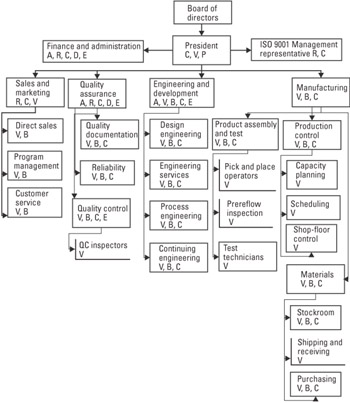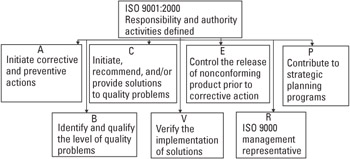9.3 Mandatory Organizational Requirements
|
9.3 Mandatory Organizational Requirements
9.3.1 Mandatory Requirements from the Registrar
The registrar requires that we define the employee certification scope because this is one of the parameters used to calculate how many assessors are required for how many days to effectively complete a certification assessment. The assessors need to know exactly how the personnel are distributed over what areas of the facility as a function of departmental activities. A common and effective way to do this task is by means of an organizational chart or an equivalent table. A chart is generally used and includes a box for the ISO management representative who normally reports directly to the site manager for ISO 9000 purposes.
9.3.2 Responsibility and Authority Required by the Standard
Clause 5.5.1 of the Standard mandates that we are to clearly define responsibility and authority within the organization and propagate such information throughout the organization.
A typical organizational chart is shown in Figure 9.1. Notice that all levels of the organization are defined. Quite often, the charts are found as an appendix to the main body of the manual. The actual names of employees are not required, although assessors are very grateful to have such a chart available in addition to the generic one.

Figure 9.1: Excellent Corporation's organization.
It is also important to include a paragraph description of the duties and responsibilities for each of the top managers. This could be an appendix but is normally placed in the body of 5.5.1: Management Responsibility.
We also see in Figure 9.1 that the various activities implied in Par. 5.5.1 of the standard are included in terms of a code in each appropriate box. The code is explained in Figure 9.2. In the 1994 version, this area of responsibility and authority was a strong area of contention as to why this requires a detailed response. The new version is less prescriptive, but just as powerful because it clearly addresses all processes and does not emphasize manufacturing-type activities, as it did in the 1994 version.

Figure 9.2: Responsibility and authority legend for Excellent's organization.
A typical paragraph would read as follows:
Engineering manager's responsibilities:
-
Assists marketing and sales in sales of new products;
-
Supports preparation of the marketing requirements document;
-
Obtains and allocates engineering resources;
-
Serves as the chief engineer;
-
Schedules and supervises engineering projects;
-
Ensures compliance to ISO 9001 design requirements;
-
Manages the transfer of product to manufacturing;
-
Supports manufacturing with continuing engineering;
-
Interfaces with customers to determine design satisfaction.
9.3.3 Job Descriptions
Job descriptions can also be used to define these functions, and specific steps in procedures can be used to enhance the descriptions. However, the manual must respond to this SHALL and be clear as to the method used to define and communicate such activities. Job descriptions should clearly indicate the requirements for education, necessary skills, acquired training, and related experience to the degree required for a given employee position or title.
9.3.4 Registrar Mandatory Interface Issues
In many cases, the certification site is part of a much larger organization. It is then necessary to define the interfaces that exist between the corporate offices and interdivisional sites. This somewhat obscure requirement is extremely important in multidivisional organizations that share operational areas (e.g., engineering, purchasing, metrology, and shipping and receiving) [4].
A typical example of such an interface chart is shown in Figure 9.3. As indicated, there are a number of corporate and divisional interfaces. The same information could be demonstrated by means of a table. In fact, when there are several dozen interfaces, a table is easier to understand.

Figure 9.3: Excellent Corporation's interdivisional relationships.
What we see in Figure 9.3 is that corporate marketing and sales provides market analysis and customer leads to the general manager. The general manager works with the in-house customer service department to close and follow up on sales. In addition, the local finance department interfaces with the corporate controller for capital equipment and fiscal budget planning.
Also, the local design capability is enhanced via the research and development facilities at the corporate level, and local purchasing obtains better price discounts by buying raw material through the corporate materials department.
In many situations, the purchase of material from another division is by means of the same purchase order that is used to buy from any subcontractor. Also, when product is shipped from one division to another the same sales orders are used as with any shipment to a customer. In that case, it is usually acceptable to state in the manual in response to 4.1: General Requirements that "All buy and sell transactions between the Excellent Corporation's operating divisions are by means of either purchase orders or sales orders that are the same formats used with either vendors or customers."
This type of blanket statement fulfills both the requirements to identify processes and to control outsourced material.
Otherwise a fairly detailed interdivisional agreement would need to be created—usually in the form of a procedure—and signed off by the two interfaced general managers. Be sure to pass such decisions by your registrar for their acceptance and comments.
A chart of this form is also extremely useful for those organizations that primarily use subcontractors to design and manufacture their products. In that case, the subcontractors may fulfill many of the roles otherwise supplied by a corporate division.
[4]See, for example, Taylor, C. Michael, "Bored with the Same Old Standards Books?" Automotive Excellence, Spring 1997, p. 6.
|
EAN: 2147483647
Pages: 155